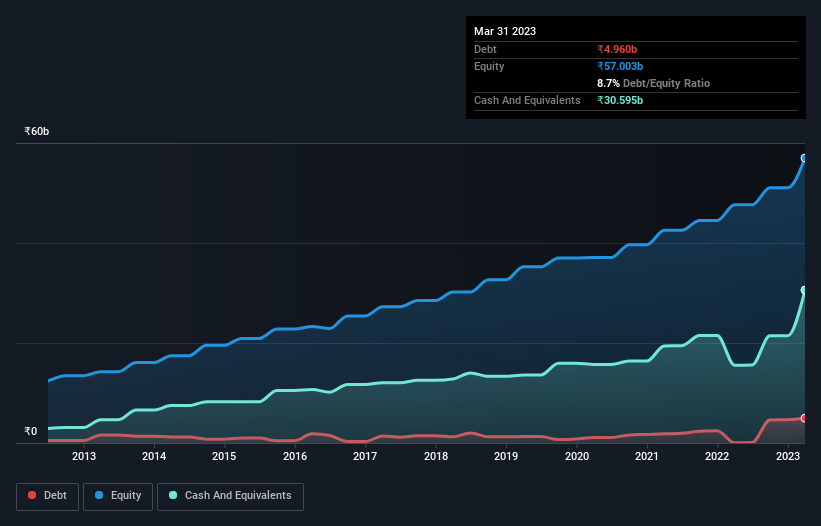Some say volatility, rather than debt, is the best way to think about risk as an investor, but Warren Buffett famously said that 'Volatility is far from synonymous with risk.' So it seems the smart money knows that debt - which is usually involved in bankruptcies - is a very important factor, when you assess how risky a company is. As with many other companies AIA Engineering Limited (NSE:AIAENG) makes use of debt. But the more important question is: how much risk is that debt creating?
When Is Debt Dangerous?
Generally speaking, debt only becomes a real problem when a company can't easily pay it off, either by raising capital or with its own cash flow. In the worst case scenario, a company can go bankrupt if it cannot pay its creditors. However, a more frequent (but still costly) occurrence is where a company must issue shares at bargain-basement prices, permanently diluting shareholders, just to shore up its balance sheet. Having said that, the most common situation is where a company manages its debt reasonably well - and to its own advantage. When we think about a company's use of debt, we first look at cash and debt together.
Check out our latest analysis for AIA Engineering
How Much Debt Does AIA Engineering Carry?
You can click the graphic below for the historical numbers, but it shows that as of March 2023 AIA Engineering had ₹4.96b of debt, an increase on ₹28.4m, over one year. But it also has ₹30.6b in cash to offset that, meaning it has ₹25.6b net cash.

How Healthy Is AIA Engineering's Balance Sheet?
According to the last reported balance sheet, AIA Engineering had liabilities of ₹8.75b due within 12 months, and liabilities of ₹559.4m due beyond 12 months. Offsetting these obligations, it had cash of ₹30.6b as well as receivables valued at ₹8.63b due within 12 months. So it can boast ₹29.9b more liquid assets than total liabilities.
This surplus suggests that AIA Engineering has a conservative balance sheet, and could probably eliminate its debt without much difficulty. Simply put, the fact that AIA Engineering has more cash than debt is arguably a good indication that it can manage its debt safely.
In addition to that, we're happy to report that AIA Engineering has boosted its EBIT by 82%, thus reducing the spectre of future debt repayments. The balance sheet is clearly the area to focus on when you are analysing debt. But ultimately the future profitability of the business will decide if AIA Engineering can strengthen its balance sheet over time. So if you want to see what the professionals think, you might find this free report on analyst profit forecasts to be interesting.
But our final consideration is also important, because a company cannot pay debt with paper profits; it needs cold hard cash. AIA Engineering may have net cash on the balance sheet, but it is still interesting to look at how well the business converts its earnings before interest and tax (EBIT) to free cash flow, because that will influence both its need for, and its capacity to manage debt. In the last three years, AIA Engineering's free cash flow amounted to 42% of its EBIT, less than we'd expect. That's not great, when it comes to paying down debt.
Summing Up
While we empathize with investors who find debt concerning, you should keep in mind that AIA Engineering has net cash of ₹25.6b, as well as more liquid assets than liabilities. And we liked the look of last year's 82% year-on-year EBIT growth. So is AIA Engineering's debt a risk? It doesn't seem so to us. The balance sheet is clearly the area to focus on when you are analysing debt. However, not all investment risk resides within the balance sheet - far from it. For instance, we've identified 1 warning sign for AIA Engineering that you should be aware of.
Of course, if you're the type of investor who prefers buying stocks without the burden of debt, then don't hesitate to discover our exclusive list of net cash growth stocks, today.
New: Manage All Your Stock Portfolios in One Place
We've created the ultimate portfolio companion for stock investors, and it's free.
• Connect an unlimited number of Portfolios and see your total in one currency
• Be alerted to new Warning Signs or Risks via email or mobile
• Track the Fair Value of your stocks
Have feedback on this article? Concerned about the content? Get in touch with us directly. Alternatively, email editorial-team (at) simplywallst.com.
This article by Simply Wall St is general in nature. We provide commentary based on historical data and analyst forecasts only using an unbiased methodology and our articles are not intended to be financial advice. It does not constitute a recommendation to buy or sell any stock, and does not take account of your objectives, or your financial situation. We aim to bring you long-term focused analysis driven by fundamental data. Note that our analysis may not factor in the latest price-sensitive company announcements or qualitative material. Simply Wall St has no position in any stocks mentioned.
About NSEI:AIAENG
AIA Engineering
Designs, develops, produces, installs, and services high chromium, wear-resistant parts for grinding equipment used in the cement, mining, and quarry industries in India, the United Arab Emirates, and internationally.
Excellent balance sheet average dividend payer.
Similar Companies
Market Insights
Community Narratives




